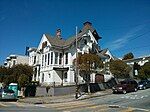Recreation Park was the name applied to several former baseball parks in San Francisco, California in the late 19th century and early 20th century.
Recreation Grounds, opened on November 26, 1868, and operated until May 1884, and was San Francisco's first professional enclosed ballpark. Located at the terminus of a railcar line in San Francisco's heavily Irish Mission District, at the present day Garfield Square. The ballpark was bordered by the streets Harrison, Twenty-Sixth, Folsom and Twenty-Fifth. The opening day ceremonies included the second game of the California baseball championship series between the Oakland Wide Awakes and the San Francisco Eagles, who won by the score of 37–23. The day's festivities included an operatic concert and footraces and were attended by a crowd of 4,000 people. 37°45′1.78″N 122°24′47.78″W Photo.
Haight-Street Recreation Grounds 1886 -1895. Another recreation grounds existed in the Haight, with ownership transferred to J.B. Gilbert of the Central league on September 8, 1893. and was also referred to as Haight-Street Recreation Park located between Stanyan, Waller, Cole and Frederic Streets was closed in 1895.Recreation Park, also known as Central Park, seating capacity of 15,000, opened on Thanksgiving Day of 1884 and operated until 1906. Located at 8th Street and Market Streets, was used by several clubs including the San Francisco Seals of the Pacific Coast League from 1903. Destroyed by the earthquake and fire on April 18, 1906. The Seals temporarily moved to Oakland while the city of San Francisco was being rebuilt. Photo.
Recreation Park, located in the Mission District 37°46′1.87″N 122°25′23.93″W, was the best known and longest-lived of these ballparks. It was the home of the Seals during 1907–13 and then 1915–30 after a one-year experiment playing at newly built Ewing Park near the Richmond District. The experiment was a fiasco, largely because of the cold and foggy summer weather endemic to western San Francisco. The Oaks, in turn, had essentially moved into Recreation Park in 1907 and played most of their games there (except Thursdays and Sunday mornings) until their new Oaks Park was opened in 1913, although they continued to play some games in San Francisco until sometime in the 1920s. This congenial arrangement was made easier by the fact that J. Cal Ewing, founding father of the PCL, owned both clubs for their first couple of decades. The ballpark sat 15,000. It also become the home of the Mission Reds (a.k.a. "Missions") upon their arrival in 1926.
The Chicago White Sox held spring training at Recreation Park in 1909 and 1910.This final incarnation of Recreation Park was on a block bounded by 14th Street (north, right field); Valencia Street (east, first base); 15th Street (south, third base); and Guerrero Street (west, left field) 37°46′2.7″N 122°25′23.32″W. The stands were an unusual design, with a small lower deck topped directly above (thus protected from the weather) by a large upper deck, much of which was unroofed and open to the sunshine and the elements. The stands were also made of wood. A new, concrete ballpark called Seals Stadium, less than a mile east of Recreation Park, opened in 1931 as the new home of both the Seals and the Missions. Recreation Park was demolished and the site was converted into a public housing project.









